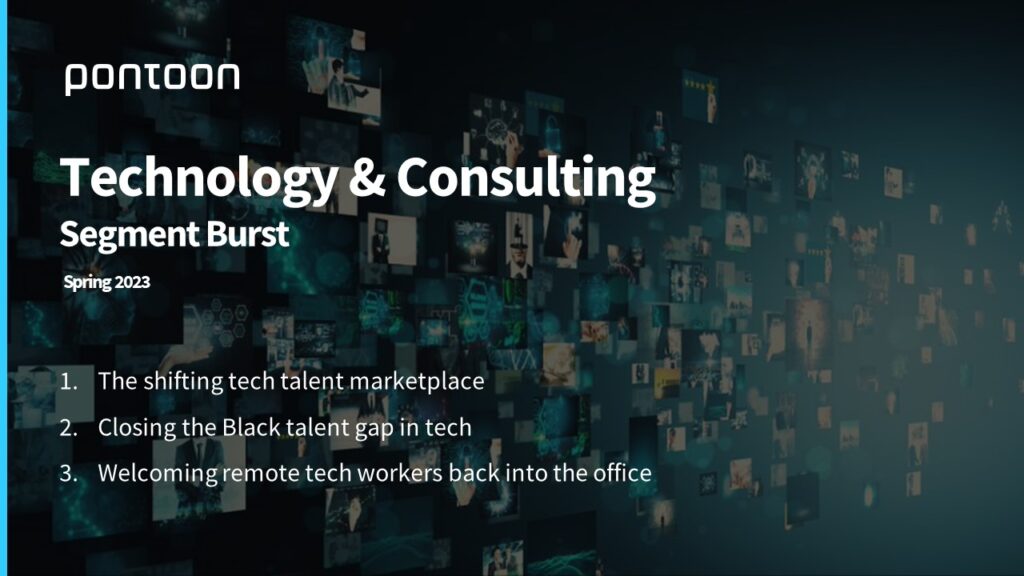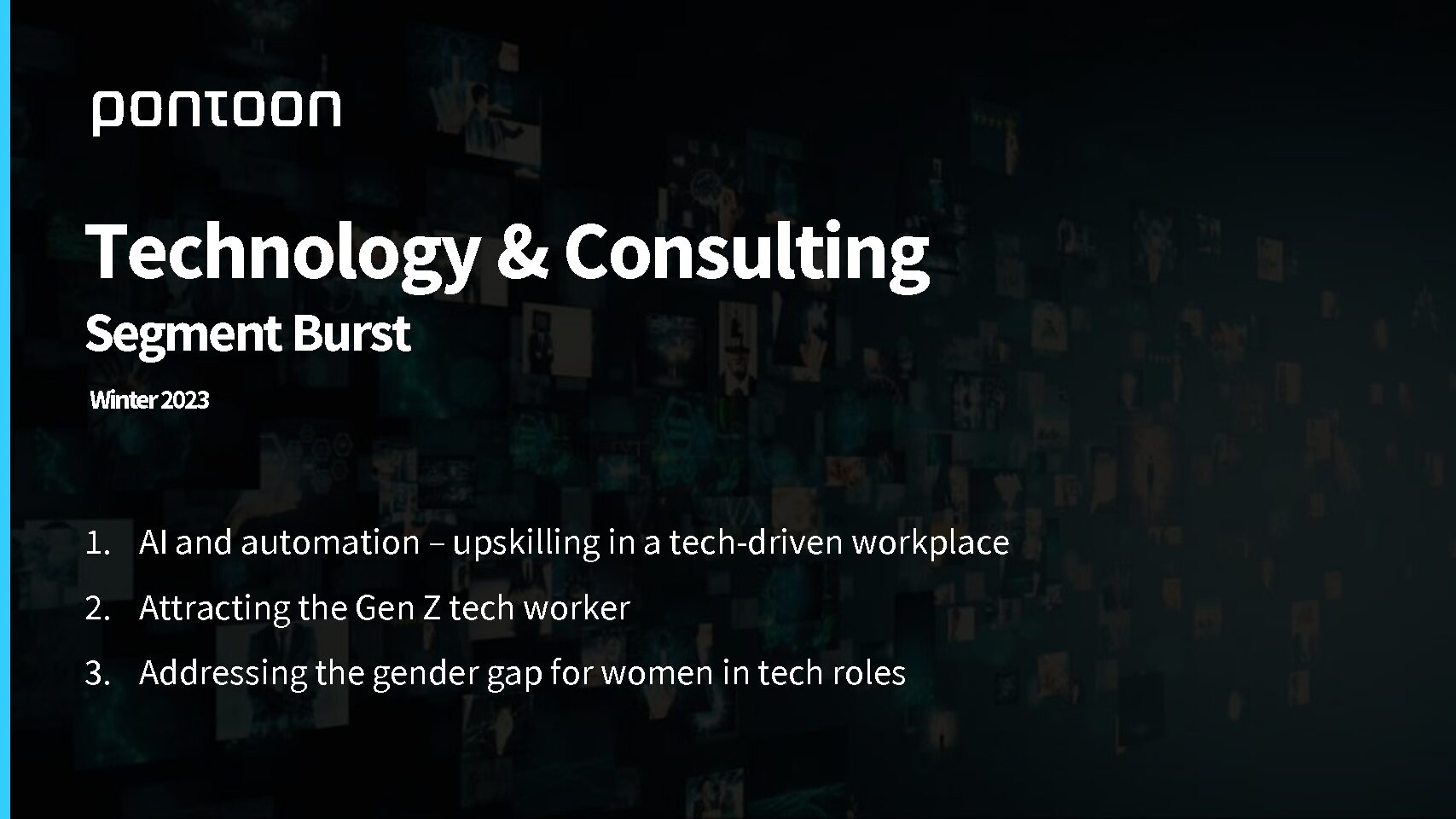Technology & Consulting Segment Burst: Spring 2023
Research
.
In the Spring 2023 Technology and Consulting Segment Burst, we explore the most recent trends in the sector.
- The shifting tech talent marketplace
- Closing the Black talent gap in tech
- Welcoming remote tech workers back into the office
The shifting tech talent marketplace
The tech talent market is still red hot, showing no signs of slowing down. A 2022 Dice tech jobs report found that tech listings were up 25% from January through October compared to 2021. However, last year’s tech layoffs have caused a major hiring shift in the industry.
Top talent is now moving away from “Big Tech” and Silicon Valley firms, instead joining traditional blue-chip companies. This is partly due to the changing tech industry landscape, with many organisations looking to upgrade their legacy technology stacks and increase cloud capabilities. For example, healthcare provider Humana and global aerospace and defence company General Dynamics now top CompTia’s report of top employers hiring for tech roles.
Traditional employers must develop strategies to attract the best developers, engineers, and other tech professionals to remain competitive in the ever-evolving tech sector. Attraction schemes include competitive salaries and comprehensive benefits packages as well as internal career development and upskilling opportunities based on the latest cloud technologies.
Additionally, companies must create an open and collaborative work environment where tech workers feel valued and motivated by meaningful and challenging projects that contribute to the organisational mission.
Identifying talent attraction techniques effective on a large and small scale can be integral in maintaining a tech company’s success, as well as having the insight and creativity to apply those approaches at an optimal level of efficiency.
By leveraging these tactics, blue-chip organisations can compete with larger market rivals — ensuring the right talent is in place to meet business demands successfully. They can also stay ahead of the curve regarding technology capabilities and modern solutions that enable them to remain competitive within their respective industries.
Closing the Black talent gap in tech
The Black talent gap in tech is widening. Despite representing almost one-eighth of the US workforce, only 8% of Black professionals are employed in tech roles. According to McKinsey, this disparity is even more evident within technology C-suites, with representation at an astonishingly low 3%.
Many companies operating in the US have been connecting with historically Black colleges and universities (HBCUs) to combat this trend, creating a pipeline for tech and STEM talent. For example, IBM and Netflix are just some corporations partnering with HBCUs. They recognise these institutions’ critical role in economic mobility for people from diverse backgrounds. Although progress has been made, there’s still an opportunity to make these partnerships even more substantial.
Tech employers must proactively and intentionally create a more diverse workplace, including recruiting Black professionals. This begins with providing accessible paths into the tech industry for workers from underrepresented groups. Employers should consider investing in professional development opportunities, mentorship programmes and internship initiatives. They must also form relationships with local community organisations that support diversity and inclusion.
Additionally, tech employers should create an inclusive work culture that celebrates diversity and fosters an environment of respect and appreciation for individual differences. This can be achieved by ensuring equal representation at all levels, eliminating biased language in job descriptions, evaluating recruitment practices, and implementing pay equity policies.
Employers need to provide resources to address any challenges workers may face during their tenure. By acknowledging past failures around hiring and supporting Black professionals while taking meaningful action to move towards a more equitable future, tech employers can create significant change within the industry.
“Tech professionals should consciously serve as catalysts of positive influence in closing this gap, ensuring the face of the tech industry is more attainable to Black women and men.”
E’Lisha Davis, Senior Director Global IT at Pontoon
Welcoming remote tech workers back into the office
Research suggests that 50% of industry leaders will return remote and hybrid workers to the office in 2023. Tech leaders should take a thoughtful and considerate approach when communicating back-to-office plans with their employees to reduce any potential resistance.
So how can tech companies welcome workers back into the office?
Being flexible and providing options are great places to start. It’s no surprise tech workers desire the freedom of choice — after all, having autonomy can lead to greater job satisfaction. Research shows that 71% of employees prefer going into the office in the middle of the week, with traffic highest on Tuesdays and Wednesdays and lowest on Fridays.
Managers should be encouraged to make sure employees’ schedules remain flexible, with alternative work hours or remote options available based on business needs.
Employers must create workspaces that empower workers to express themselves and unlock their potential. This includes providing specific collaboration, connection, and socialisation areas so colleagues can work seamlessly and safely together. It’s also essential to give tech workers access to private spots where they may focus on important tasks undisturbed.
Companies can integrate nature into the workspace to maximise well-being by providing abundant natural light, taking full advantage of outdoor elements like plants and water features. They should also provide additional mental health and counselling resources for employees who may experience anxiety from the remote to in-office transition.
Related Post
In the Winter 2023 Technology and Consulting Segment Burst, we explore the most recent trends in the sector.
Why is upskilling in a tech-driven workplace so important?
How to attract ...





